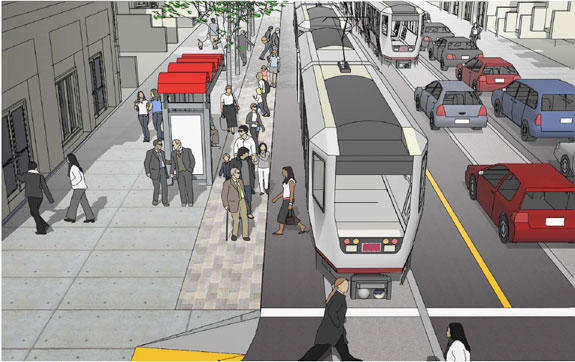
A plan [pdf] to widen the sidewalks and install transit bulbs on Carl Street at Cole and Stanyan is headed to the SFMTA Board after being approved at an engineering hearing this morning, though not without controversy. Even though it would significantly enhance safety and convenience for passengers at all three stops, and improve dwell times, it has drawn vociferous opposition from some neighbors who are upset by the prospect of losing nine parking spaces.
The Muni stops in Cole Valley have been a problem for years. The sidewalks can't accommodate the thousands of passengers who use the stops daily, so riders often wait in the street and are forced to weave through parked vehicles to access the trains. The outbound stop poses a unique problem because the tracks curve as the trains exit the Sunset tunnel and parked cars create a blind spot for operators who aren't able to see passengers at the rear of the train. In addition, drivers sometimes illegally park in a spot that is clearly marked "No Parking."
"When they do that they can encroach into the dynamic envelope of the train and either the N-Judah has to stop and wait for that car to move or occasionally they'll make a misjudgment about how much room is there and they'll proceed anyway," said Britt Tanner, an engineer in the SFMTA's Sustainable Streets division. She said the illegally parked cars have led to an average of one sideswipe per year.
To fix the problem, the SFMTA wants to remove the two parking spaces along that stretch of Carl around the outbound stop and widen the sidewalk by 9 feet. The bulb would stretch for 98 feet. For the inbound stop at Carl, five parking spaces would be replaced by a bulb that would stretch the entire length of a two-car train (165 feet) and the sidewalk would be widened by 5 feet.
"By having the bulb run the length of the train we'll be able to encourage passengers to use the rear car which is less crowded and reduce dwell times," said Tanner, who added that the sidewalks would only being widened by 5 feet for the outbound stops because anything more than that would be difficult for the N-Owl buses to navigate. Leaving a four-foot gap will also have an added benefit for bicyclists, she said.
The plan for the inbound stop at Stanyan is similar, except that only two parking spaces would be removed and the bulb would be shorter at 59 feet.

"I'm for this improvement strictly from a safety point," said Muni operator Larry Woods, who has been working on the N-Judah line for 20 years. "The time has come when you don't want people standing in the street waiting for a car."
When there are gaps in service, he said, "that sidewalk is not big enough for all those people." This morning, people were "all up in the middle of the street between the parked cars facing east as my train comes up. They've got head devices in their ears, they don't see me, they don't hear me. The sidewalk, that's the best way to go. Safety first."
"It speeds up loading and unloading," said Howard Strassner of Rescue Muni. "It increases reliability. If the train sometimes takes 10 seconds to load or sometimes takes a minute and 10 seconds to load, that screws up the whole schedule."
Some residents and the owner of one longtime business in the area, however, showed up at the hearing to testify against the plan.
"Some people, Rescue Muni, are speaking that these parking spaces don't mean anything. They mean something to the people that make a living in that neighborhood and support families, from businesses who employ people in the neighborhood," said Roger Soulah, the owner of Say Cheese, who complained that Muni drivers "fly out" of the tunnel and "do not look."
Other residents complained about the difficulty of locating parking in the area, often circling for 20 minutes to find a space. One man who was carrying a bike helmet and identified himself as an urban designer said the parking is used 24 hours "whereas if you designate it for transit riders that's only about three or four hours a day. So, using the space for parking makes more sense from a land use perspective as opposed to using it for transit riders that only use the space for three to four hours a day."
The SFMTA hearing officer suggested that businesses worried about their driving customers should encourage them to use a parking lot on Stanyan Street near Kezar Stadium.
Tanner said the plan has the support of the Cole Valley Improvement Association and the Haight-Ashbury Neighborhood Council, but staff is expecting the same opposition when it goes before the SFMTA Board December 7. If approved, the bulbs would be built in 2012 at the same time the SFMTA begins work on a rail improvement project.





